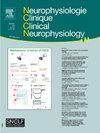The Reticular formation: An integrative network for postural control
IF 2.4
4区 医学
Q2 CLINICAL NEUROLOGY
Neurophysiologie Clinique/Clinical Neurophysiology
Pub Date : 2025-09-01
DOI:10.1016/j.neucli.2025.103100
引用次数: 0
Abstract
The reticular formation (RF), a complex network within the brainstem, plays a pivotal role in postural control, by integrating multisensory information and coordinating motor responses, to maintain balance and stability. This theoretical review synthesizes current knowledge on the anatomical and functional organization of the RF, highlighting its contributions to muscle tone regulation, anticipatory postural adjustments (APA), and gaze stability. Anatomically divided into median, paramedian, and lateral columns, the RF operates through both ascending and descending pathways. The ascending reticular activating system (ARAS) regulates arousal and alertness, while the descending reticulospinal tracts modulate postural muscle tone and motor coordination. Functionally, the RF maintains baseline muscle tone via excitatory and inhibitory pathways and supports APA by preparing the body for movement-induced perturbations. Moreover, the RF is integral to the coordination of eye and head movements, ensuring visual stability during motion. Collectively, these mechanisms position the RF as a central integrator of posture and movement, with implications for understanding motor control and informing interventions in neurorehabilitation and movement optimization.
网状结构:姿势控制的综合网络
网状结构(RF)是脑干内的一个复杂网络,通过整合多感觉信息和协调运动反应,在姿势控制中起着关键作用,以保持平衡和稳定。这篇理论综述综合了目前关于RF的解剖和功能组织的知识,强调了其对肌肉张力调节、预期姿势调节(APA)和凝视稳定性的贡献。在解剖学上分为正中柱、旁正中柱和侧柱,RF通过上升和下降通路起作用。上升网状激活系统(ARAS)调节觉醒和警觉性,而下降网状脊髓束调节体位肌张力和运动协调。功能上,RF通过兴奋和抑制途径维持基线肌张力,并通过使身体为运动引起的扰动做好准备来支持APA。此外,射频是不可或缺的眼睛和头部运动的协调,确保运动过程中的视觉稳定性。总的来说,这些机制将RF定位为姿态和运动的中心整合器,这对理解运动控制和告知神经康复和运动优化干预具有重要意义。
本文章由计算机程序翻译,如有差异,请以英文原文为准。
求助全文
约1分钟内获得全文
求助全文
来源期刊
CiteScore
5.20
自引率
3.30%
发文量
55
审稿时长
60 days
期刊介绍:
Neurophysiologie Clinique / Clinical Neurophysiology (NCCN) is the official organ of the French Society of Clinical Neurophysiology (SNCLF). This journal is published 6 times a year, and is aimed at an international readership, with articles written in English. These can take the form of original research papers, comprehensive review articles, viewpoints, short communications, technical notes, editorials or letters to the Editor. The theme is the neurophysiological investigation of central or peripheral nervous system or muscle in healthy humans or patients. The journal focuses on key areas of clinical neurophysiology: electro- or magneto-encephalography, evoked potentials of all modalities, electroneuromyography, sleep, pain, posture, balance, motor control, autonomic nervous system, cognition, invasive and non-invasive neuromodulation, signal processing, bio-engineering, functional imaging.

 求助内容:
求助内容: 应助结果提醒方式:
应助结果提醒方式:


